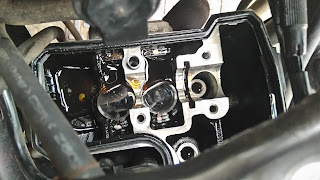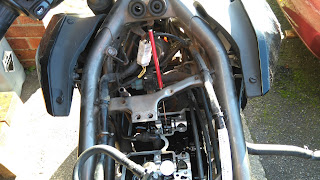So you've got to 19473 miles and getting twitchy because you've not checked the valve clearances since you last looked at 8470 and Kawasaki recommend a check every 7600 miles (it's surely not just me??). Upon checking you find the clearances are all right at the tight end of the spec except for right exhaust which is just a smidgen too tight. Here's what you do..
Firstly you need to get access to check the clearances (if you have not done so already). You can find my world-class guide right here. Now on to the interesting stuff.
This guide starts assuming you've already got the rocker cover off and have already tried to get your tool to fit but the hole is even tighter than you wanted. The first step is to remove the inspection cap from the alternator cover, a neat trick I learnt on BAT is that you can use a coin and a pair of pliers to turn out the cap without mashing it up like you would with a big screwdriver that doesn't fit the slot. Happy days!
If you're in the UK then a late, steel 2p is just the ticket. If you use a copper one it will just bend and twist. If you're not from the UK then you're on your own.
Next up is to put the bike in 6th gear and turn the rear wheel in the direction it would turn when travelling forward, this is to turn the engine over so that you can line up the "T" mark on the flywheel with the notch in the inspection hole. You'll probably miss it the first time but don't worry. If you do miss it then carry on going round, do not try and go backwards as you'll be hammering against the starter clutch.
With the crank at "T" hopefully the cam lobes are all miles away from pushing on any buckets - this is TDC on compression and actually you should've found this when checking the clearances so why are you doing it again here? If they are touching buckets then go round back to "T" again.
With that sorted it's time to remove the cam chain tensioner. This is on the right side of the motor, funnily enough where the cam chain is.
Remove the large bolt in the centre first to remove the spring tension and the tensioner's need to extend (which could possibly strip the threads for the mounting bolts when they're halfway out). This will pop out with the spring but not very strongly, don't worry. With the big bolt and the spring removed feel free to remove the two smaller mounting bolts, I used two different spanners to get at the inner one.. What a pain it is.
With the tension off the chain we can now remove the one-piece cam cap/holder/thing. In order to get to the bolts at the front you may find it best to slide this doodad off its peg:
And then it's just a bit of lefty loosey.
The holder has numbers cast into it for each bolt, start at the highest number (8) and work downwards. Crack them a bit, then go round again, and then maybe again to actually fully release them. If you fully remove each bolt straight away then you risk warping the cover which would be a Bad Thing.
Notice how the exhaust cam has a notch in it's holdy-in-placey-disc thing. That is all that differs it from the inlet cam so don't go forgetting!
As a side note I have no idea what this is for but it's great because it stops the cam chain from falling down the tunnel. Thanks Kawasaki!
It's even sealed on the outside, all this work and expensive for what??
After all that simply pluck the came out, lift up the left side first and as the shaft pivots it'll take the tension off the chain. Do whatever works for you. With the cams out we're at the buckets, easy innit?
Time to remove the buckets. These have to stay pristine so don't go grabbing them with pliers. I find a magnet on a stick works incredibly well, they just slide up and out.
And the shim:
Alright that's probably not true and the shim is stuck inside the bucket but this is where it's supposed to be.
Simply measure the shim with a micrometer (you've got a micrometer right? You better had because the size markings were all worn off the shims I took out..) and then do what you like but make sure not to mix up the buckets and their holes because they can be a matched pair. I just measure each shim one at a time and reassemble them before moving on to the next one. I also take notes of what I find with the micrometer but again that's up to you, perhaps you're some kind of memory genius. Compare your shim sizes to the clearances you found and do the appropriate calculation to find out you need to buy some shims. For reference this is what I found at 19473 miles:
Clearance spec from Kawasaki:
Inlet: 0.10-0.19mm
Exhaust: 0.15-0.24mm
My clearance findings:
Left inlet: 0.10-0.15mm (kinda tight on the feeler, mebbe 0.12ish?)
Right inlet: 0.10-0.15mm (even tighter than the left one)
Left exhaust: 0.15-0.20mm (tight on a 0.15mm feeler)
Right exhaust: 0.10-0.15mm (just under 0.15mm, 0.10mm feeler slips in and out)
Shims found in my motor:
Left inlet: 296
Right inlet: 301
Left exhaust: 292
Right exhaust: 291
This meant that I could use the 291 in the left inlet and the 292 in the right inlet and they'd be right up at the looser end of the scale, so that's a few quid saved. Unfortunately I did have to buy a 285 and a 280 for the left exhaust and right exhaust respectively. I actually bought some aftermarket shims from "dirtbikestore" which were much cheaper than Kawasaki items and proved to be machined bang on spec as confirmed by my micrometer - recommended!
Installation is pretty straight forward if you've got this far, pull out the buckets and shims again and pop in your new shims. Give everything (including the shims!) a coat of oil before putting it back together, just a dribble over it in place is fine.
Ensuring the buckets are all fully rammed home and the crank is still at "T", start fitting the cams back in. I found it easiest to fit the exhaust cam first, it gives you a bit more slack to play with. Fit the specially ribbed exhaust cam back with the "EX" marks horizontal along the top of the head, ensuring there isn't enough slack in the chain to allow it to move out of time - the chain at the "front" needs to be quite taught to make sure the timing is right.
Now the real game begins, fitting the inlet cam into the chain so that the "IN" marks stay horizontal with the top of the head but also making sure the exhaust cam doesn't go out of time. This took me several goes but they both need to have their marks lined up with the top of the head. There's also not a lot of slack in the chain to add to the enjoyment. Eventually..
Next up is to fit the cam cap holder thinger. Did you notice the shiny steel cap things in it?
These are used at the factory to prime the holder with oil so that the cam doesn't run dry for the first few revolutions. The manual says to make sure that these cap things are still securely in place after installation because the air pressure from mounting it could cause them to pop out. I forgot but you should remember!! Anyway..
Use the numbers cast into the cam holder to know which order to tighten the bolts - handy innit! We're aiming for 12Nm on these bolts but as always do it in stages, first snug them down then aim for ~6, then maybe 10 and finally 12. If you don't have a small torque wrench then all I can say is 12Nm isn't all that tight.
We're most of the way there now but don't be tempted to turn the motor round just yet, we still have to put the tensioner back in. This is a standard ratchet affair, first you need to press on the "pawl" (the pivoty black bit) to release it, and then push the big black ratchety plungery tooth bit back inside.
If you don't reset the tensioner like this then you risk breaking something when you bolt it back into place. Speaking of which, bolt it back into place with the small mounting bolts.
Only now it is safely/strongly install can you reinstall the spring, bolt and washer.
Just shovel it all down the middle of the tensioner, it's not complicated, and tighten the end bolt until it's not going to fall off or let oil leak past the washer.
And that is pretty much it. Turn the rear wheel some more to make sure the valves aren't hitting the piston (another Bad Thing) and that the marks on the cam sprockets are still level and correct. If they're not then you have to go back and do it right, if they're fine then tighten the inspection cap back in and put all the ancillaries back on. Then, after all that, cross some fingers and thumb the starter.. Hopefully it'll go well enough but sound a bit more rattly, as is always the sign of a good job!(?).




























